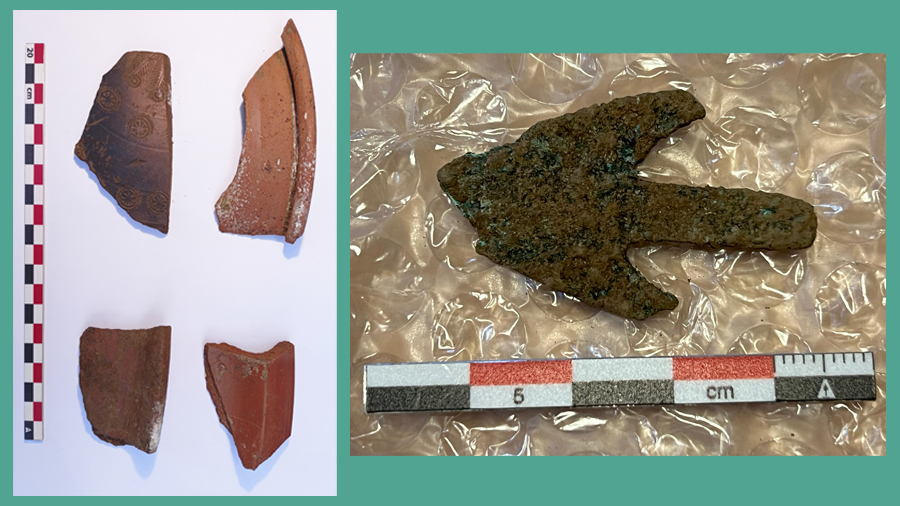Ceramic remains confirm usage of the "Home Mort" cave in Soriguera in Roman times
This year's dig campaign conducted by UAB and CSIC archaeologists at the Home Mort cave in Soriguera (Pallars Sobirà) has uncovered ceramic remains dating back to the end of the Roman Empire (5th century CE), as well as a unique bronze arrowhead dating back more than 3,500 years. Ceramic fragments corresponding to the end of the Neolithic and Calcolithic periods, which points to the usage of the cave in different time periods and makes it an essential site in understanding human occupation of the High Pyrennees region over thousands of years.

Archaeologists from the High Mountain Archaeology Group (GAAM), formed by researchers from the Universitat Autònoma de Barcelona (UAB) and the Consejo Superior de Investigaciones Científicas (CSIC), have announced today the results of the excavation campaign carried out this June in the Cova de l'Home Mort (Soriguera, Pallars Sobirà, Lleida), which they describe as "of high scientific relevance".
One reason for this is the discovery of Roman ceramics, some of North African origin. This discovery confirms that the Cova de l'Home Mort, in addition to the Bronze Age, hosted human occupations at the end of the Roman Empire (5th century CE) and "consolidates the data of recent years, which indicate that the valleys of Pallars Sobirà were not left out of the historical dynamics in Roman times, as had been traditionally mentioned on several occasions," said Ermengol Gassiot, director of the GAAM of the Department of Prehistory at the UAB.
Another reason is the numerous human remains and objects associated with the Bronze Age, between 3,500 and 3,600 years old, that have been recovered. Among the objects, a large and diverse ceramic production and unique objects were recovered, among which a bronze arrowhead stands out. "This is a very valuable object for the Pyrenean archaeological heritage, given the scarcity of similar pieces that have been found so far," researchers pointed out.
As for the human remains, "a first evaluation shows a high presence of bones of children, although there are also documented bones of elderly people," explained Xavier Sanchez, archaeologist of Pallars Sobirà and member of GAAM, also coordinator of this year's campaign.
The Cova de l'Home Mort (Soriguera, Pallars Sobirà) is a cave with two galleries located in the Pyrenees, at an altitude of 1,180 meters. This year's findings have been made in the entirety of Gallery 1, the same one in which in 2008 the site was first documented and in which several human remains were recovered that in 2017 could be dated to be between 3,500 and 3,600 years old. The amount of human fragments recovered so far is typical of the sepulchral character that the cave would have had for at least 125 years.
To date, the Bronze Age human remains documented and dated in the Cova de l'Home Mort are among the oldest recovered in the western Pyrenees of Catalonia and have the same chronology as those of the burial cave of Montanissell, in the municipality of Coll de Nargó (Alt Urgell, known as the Lady of the Mountains). Their study will contribute to understand the living conditions of human populations in the mountain and high mountain areas of the Pyrenees in a period in which the consolidation of human impact in high mountain environments is documented.
However, the study of the human occupation of the cave could extend the temporal range of this occupation, because this year's dig has also provided archaeological remains that, due to their characteristics, seem to come from the end of the Neolithic or Chalcolithic, about 5,000 to 4,500 years ago, including remains of bell-shaped pottery. "Pending the development of research, this fact confirms an archaeological sequence that covers several thousand years. This makes it a reference site for the study of human presence in the mountain areas of the Pyrenees during the past 5 millennia", emphasised Ermengol Gassiot.
This year's research was carried out with the participation of students from the UAB bachelor's degree in Archaeology.
GAAM members excavating in the Cova de l'Home Mort. Image: GAAM-UAB
The archaeological work conducted in the Cova de l'Home Mort is part of several grants from the Natural Park of the High Pyrenees and forms part of the four-year archaeological research project "Archaeology of pastoralism and prehistoric agriculture in the Western Pyrenees", funded by the Ministry for Culture of the Government of Catalonia and as part of the project "(Re)thinking the management of open spaces and extensive livestock in the High Pyrenees in the context of climate change (Repica)", funded by the AGAUR (Government of Catalonia). In relation to the latter, the Cova de l'Home Mort is providing interesting data on the evolution of the Siarb valley since the last glacial period. It will also allow, through its archaeozoological remains, the study of the evolution of livestock strategies existing over the last 3,500 years.